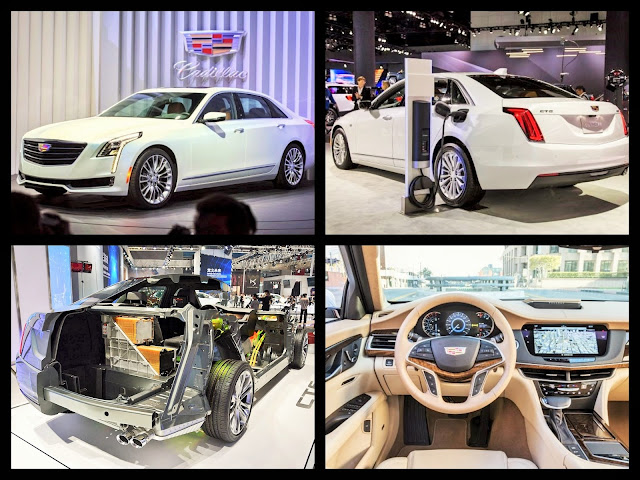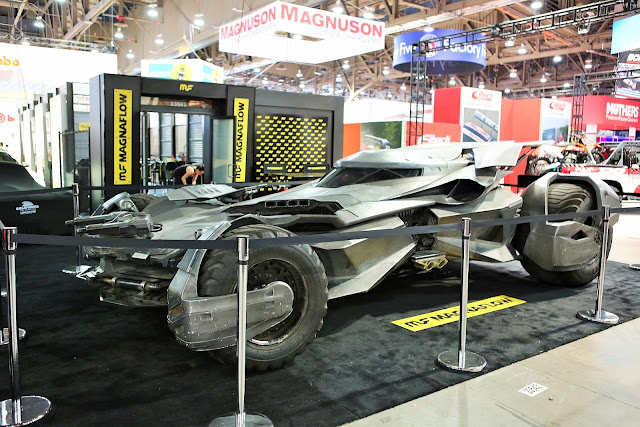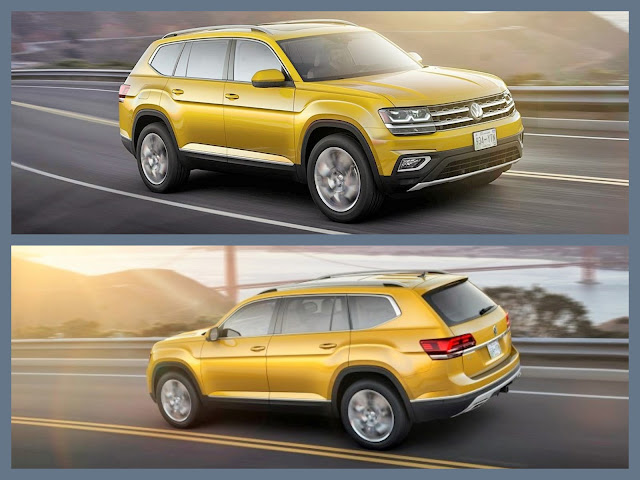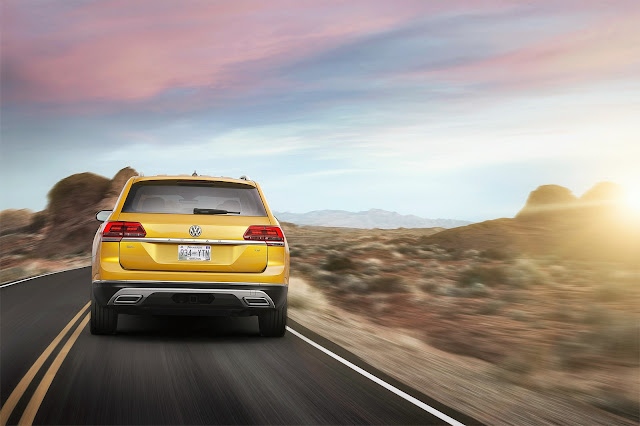Welcome to Adam's Autos! "Where I rate autos to help YOU find an A-Rate ride!" Adam’s Autos is a creative medium dedicated to providing consumers with the appropriate information to make an informed new or used automotive purchase. Additionally, Adam’s Autos highlights and promotes local businesses, alongside a variety of today’s latest automotive trends and topics. I also discuss my own personal cars and projects. So fasten your seat belts! We're going for a ride!
Search Adam's Autos Content
Thursday, November 24, 2016
Happy Thanksgiving 2016
Monday, November 21, 2016
5 Interesting Cars from the Los Angeles Auto Show 2016
Another
week, another auto show! This year’s auto show in L.A. has shown off some very
interesting concepts and upcoming production models. It’s always exciting to
think of the future and picture ourselves in the latest rides. Thus, here are
five interesting cars from the Los Angeles auto show that we’ll see on roadways
sometime soon!
1. 2018 Alfa Romeo Stelvio &
Stelvio Quadrifoglio: Roadway Name, New to the Game
 |
| Italian genes run deep, even in the name of this new SUV from Alfa Romeo. |
The Stelvio
will be Alfa Romeo’s new SUV assembled in Italy and rides on the same platform
as the Giulia. Three trim levels will be offered, starting with the base
Stelvio, then Stelvio Ti, and the top-of-the-line Stelvio Quadrifoglio
performance model. Word is that the Stelvio Quadrifoglio will have enough
unique features and tuning to where it could be considered its own model. Throw
in that model’s 505 horsepower 2.9-liter turbocharged V6 engine borrowed from
the Giulia Quadrifoglio, and imagine that this top model will live up to those
expectations. The lower trim levels of the Stelvio will utilize a 2.0-liter
turbocharged inline-four-cylinder engine paired to an eight-speed automatic
transmission.
Aluminum
largely comprises the makeup of the Stelvio, and all-wheel-drive is available.
Why wouldn’t it be on an SUV, after all? Up to 60 percent of the torque can be
sent to the front axle if needed, and the system is linked to the Alfa DNA
Drive Mode in the car. You’ll be able to select from Dynamic, Natural, and
Advanced Efficiency modes to modify things such as throttle response and boost
pressure on the Ti and Quadrifoglio trims. In terms of the interior and available
features of the Stelvio, leather seating with contrast stitching, push-button
start, a rearview camera, 7.0-inch TFT screen, and a power rear hatch are all
standard. Also, all-wheel-drive is standard, a plus if you live in places with
nasty weather. Some available options are a 14-speaker, 900-watt Harman/Kardon
audio system and various rim options ranging between 18 to 21 inches.
Overall, this
model looks intriguing. I love the black rims, and paint on the SUV, as both
combined really seem to set this design off. However, I initially thought that
this was a very compact hatchback at first glance, and that may turn off a few
buyers. Additionally, no pricing or on sale date has been announced yet, and
Alfa Romeo has a history of teasing us and then making everyone wait forever
for their products it seems like… Regardless of when this model may actually show
up, at least we can relish in the fact that we actually have an idea of what
Alfa Romeo’s portfolio may actually look like.
2. 2017 Cadillac CT6 Plug-In Hybrid:
Big Luxury, Smaller Footprint
Manufactured
in China, the Cadillac CT6 plug-in hybrid is relatively unique. It has very
little competition here in the United States in its class outside of the
Mercedes-Benz S550e and Porsche Panamera E-Hybrid. Its only other competition
will be smaller, non-luxury electric and hybrid cars. However, I would expect
that other manufacturers, such as Hyundai’s new Genesis luxury brand and maybe
even Lincoln’s new Continental, will follow suit eventually and introduce
hybrid and electric luxury car rivals that will give this version of the CT6 a
run for its money.
The CT6 plug-in
hybrid will have an 18.4-kWh battery pack that powers two 100 HP electric
motors. This is expected to give the car an EV range of 30 miles and an MPGe
rating of around 65. Both of these motors are also supposed to take the CT6 up
to a top speed of 75 mph on electric-only power, which is impressive. After
that point, the car’s regular engine kicks in to supply more juice. What you’ll
find under the hood of this big electric Caddy is a 2.0-liter turbocharged
four-cylinder engine that when combined with the dual electric motors, makes
335 horsepower and 432 pound-feet of torque. Good numbers, especially when you
consider that this is essentially equal to or better than the other engines
that the CT6 offers in its gas counterparts. This powertrain will be paired to
a CVT (continuously variable transmission) and unfortunately, all-wheel-drive
won’t be offered on this model. Likely due to its incompatibility with various
hybrid components under the vehicle.
Pricing of
the regular 2017 CT6 starts at $53,495, but the new plug-in hybrid will start
at a hair over $76,000 before federal tax incentives. For that price, you get a
nicely equipped, unique, and efficient luxury sedan with features such as
heated and cooled seats and a panoramic sunroof. For all the audiophiles out
there, I’m sure Cadillac will offer their 34-speaker Bose Panaray sound system
as an option as well (if it’s not standard). Given that the CT6 is still a
relatively new player in the executive luxury car segment, it’ll be interesting
to see how this entire lineup fares in the coming years given its promising driving
dynamics and architecture. I had a chance to briefly sit in a new Cadillac CT6
not long ago, so check back for that video in the future.
3. 2018 Ford EcoSport: Mini-Me SUV
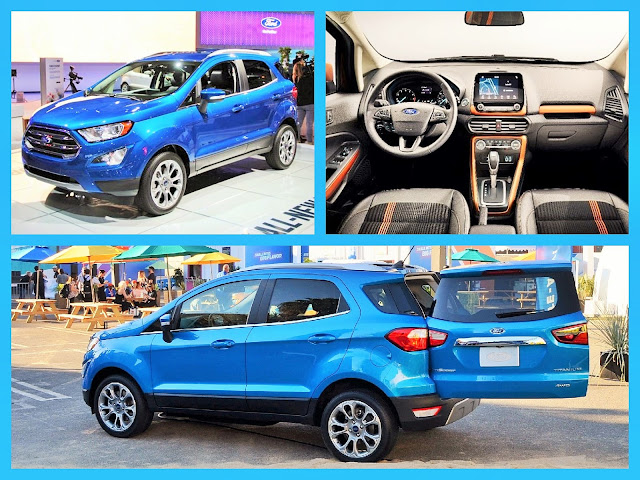 |
| After being curiously absent in the subcompact SUV segment for the past several years, Ford is finally bringing the EcoSport to the United States. But not for some time still... |
The
subcompact SUV segment is on fire these days, and almost every manufacturer in
the United States has had at least one entry in this segment except Ford it
seems like. Suzuki, who’s not even active in the North American market anymore,
even has had an entry and technically beat everybody to this trend roughly a
decade ago when they introduced their SX4 hatchback back in 2007. Thus, it was
clearly time for Ford to throw their hat into the ring. Enter the EcoSport (pronounced
ECHO-Sport), which has already been on sale elsewhere for some time. But it’ll
be new to us here in America.
Ford is
very confident in the EcoSport’s potential success here, partially because it’s
been so successful globally. And I believe that they’re spot on in their
assessment. For one, it looks like a baby Escape, which already sells quite
well here in the United States. And additionally, the segment it competes in is
in high demand and it’ll likely be competitively priced. All factors that work
in this new model’s favor. Two engines will be offered on the EcoSport: a
1.0-liter turbocharged three-cylinder Ecoboost engine, and a 2.0-liter naturally
aspirated four-cylinder. The 2.0-liter engine will be paired with
all-wheel-drive, both engines will be paired to a six-speed automatic
transmission, but final output figures of both aren’t, well… Finalized yet.
On the
interior, Ford’s conventional design language can be seen in use here and works
well with the two-tone scheme that was shown off at the auto show on SES trim
levels. I really like the multilayer storage system in the rear of the EcoSport
a lot, and there’s over 30 different storage cubbies around the interior! Push-button
start is available and an 8.0-inch touchscreen infotainment system is smack in
the middle of the dashboard and runs on Ford’s Sync 3 system, which by all
indications is far improved over its predecessor, MyFord Touch. Other available
options include a 675-watt 10-speaker audio system. However, personally I’m no
fan of the whole “floating touchscreen” design that’s been popping up in more
cars, such as the EcoSport and Mazda’s lineup of cars. It looks a little “aftermarket”
to my eyes. Additionally, the swing out rear door seems a little unconventional
to me for the American market. A lift-up hatch might be more space efficient,
but I must admit, that hiding the release handle for the door under the reverse
light was clever.
Overall,
this is a good effort and I don’t doubt it’ll do fine in its segment. Look for
the EcoSport to go on sale in early 2018. Yes, that’s still another entire year
and some change away, I know. But remember: Better late than never.
4. 2018 Jeep Compass: A New Direction
for An Old Name
 |
| The new Jeep Compass is an old name, but this new design is much more mature in nature, from top to bottom. |
Here’s a
name you’re likely familiar with: Jeep Compass. This model has been on sale
since I was in middle school, and that was literally a decade ago now. To say
it was time for a redesign would be an understatement, as the outgoing Compass
was based on the Dodge Caliber hatchback, which was last produced for the 2012
model year. Despite how dated the platform was, Jeep couldn’t stop selling
enough of the Compass and Patriot duo. Both are part of a hotly sought after
segment right now: Compact SUVs. But the Compass name will be the one to continue
on, and this new model will slot in between the subcompact Renegade and compact
Cherokee in Jeep’s lineup. It’s almost as if Jeep is carving out their own
segment to compete in.
One of the
first things you’ll likely notice is the handsome styling of this new Compass,
inside and out. Overall, this new model continues the “baby Grand Cherokee”
theme of the previous model, but with a much more upscale, mature twist. It
also doesn’t look “funky” like the slightly larger Cherokee may appear to look
to some. Trailhawk models add signature styling elements such as red tow hooks,
exterior badging, and unique front and rear bumpers. Trailhawk models also
benefit from additional ground clearance, off-road tires, a special painted
hood and roof, and receive Jeep’s “Trail Rated” badge. Base Sport models come
well equipped with features such as push-button start, a backup camera, power
windows and mirrors, and Bluetooth with a 5.0-inch Uconnect touchscreen. A
larger updated 8.5-inch Uconnect touchscreen with Android Auto and Apple
CarPlay is available on higher trims, and Limited trims come standard with
nearly everything, from heated leather seating to remote start. Much of the
latest safety equipment is available as well, such as blind-spot monitoring and
automatic emergency braking.
Under the
hood, only one engine will be available on the new Compass, and it’s a familiar
one. Chrysler’s 2.4-liter Tigershark four-cylinder good for 180 horsepower and
175 pound-feet of torque is the only option. Front-wheel drive will be standard,
and a six-speed automatic or manual transmission will both be available.
However, the manual will be available on the lighter-duty all-wheel-drive
system. A different 4x4 system is exclusive to the Trailhawk models. Opting for
the automatic transmission with Jeep’s Active Drive system will get you a
nine-speed automatic transmission, which has had its sour spots for
Fiat-Chrysler in the past. Every all-wheel-drive Compass will come with Jeep’s
Selec-Terrain drive mode system, which allows you to optimize your drivetrain for
snowy, muddy, or sandy conditions. Personally, I would love to see a turbo
four-cylinder make its way into this new Compass. I imagine that the Tigershark
engine may prove to be underpowered, especially when off-roading. I can
understand why Chrysler didn’t put a V6 option into this new model, as that
would potentially cannibalize sales of the slightly larger Cherokee.
Overall, I
think the new Jeep Compass is a great effort. Then again, it’s not that hard to
improve over the old Compass. With the right marketing and the availability (hopefully)
of an additional engine option over the base 2.4, I think that this vehicle
will continue to be successful. I might even have to check one out myself.
Pricing will most likely fall somewhere between that of the Renegade and the
Cherokee in Jeep’s lineup. The all-new Compass will release next year, but will be sold alongside the old Compass for a short time as well.
5. 2017 Mazda CX-5: Zoom-Zoom With
Room to Spare
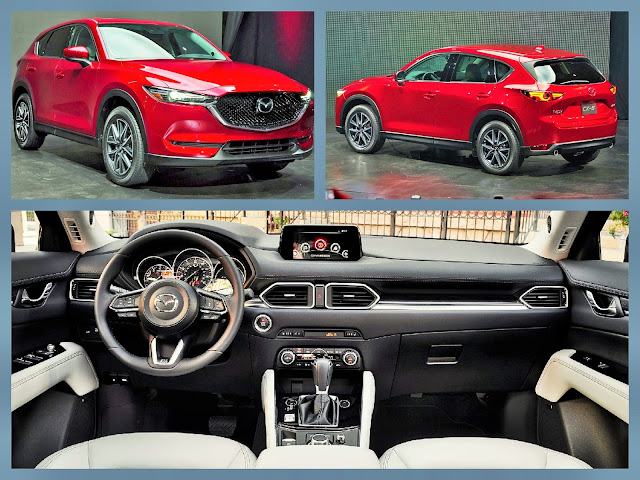 |
| The new Mazda CX-5 continues to expand upon the brand's Kodo design language and clearly takes quite a few cues from the larger CX-9 crossover too. |
While the 2017 Mazda CX-5 may look all new, its actually riding on the same platform as before. What’s truly new is the car’s exterior and interior design. Mazda refers to some of their design inspiration as “reflection-based surfacing”, or in other words, “How will the environment reflect into the car and interact with it?” This inspiration complements the evolution of the brand’s Kodo design language well, and is perhaps seen best in the CX-5’s grille, which draws its upscale inspiration from its CX-9 big brother.
Under the
hood, Mazda’s 2.5-liter four-cylinder engine with 184 horsepower returns as the
sole powertrain for the new CX-5. Also, Mazda’s G-Vectoring Control system that
seeks to improve steering response has been added to the car. The biggest news,
however, is that Mazda recently announced plans to finally bring their diesel
technology to the United States after years of promising. It’s been confirmed
that CX-5 will be the first to get their new engine (it was originally supposed
to be the Mazda 6). A 2.2-liter turbocharged Skyactiv-D clean diesel engine
will be available in the second half of 2017 on the CX-5. It should be good for
170 horsepower and 310 pound-feet of torque, and tuned to meet more stringent
U.S. regulations for nitrogen oxide emissions. Both engines will be paired to a
six-speed automatic transmission, and the six-speed manual may return
eventually. Mazda claims that this diesel engine will make the CX-5 of the most
efficient in its segment, including hybrids.
Now speaking
of hybrids and alternative energy, Mazda will also introduce an electric vehicle
in 2019 and a plug-in hybrid model in 2021 to meet new fuel economy
regulations. Which existing models those may be or if they’ll all be entirely
new, we have yet to find out.
Back to the
CX-5: On the inside, the theme of “upscale” continues with new features such as
heated rear seats and a revised heads-up display. Mazda says that the dashboard
is designed to be driver-centric and that the company is focused on people. Thus,
improving visibility outward, making the gauges more vivid with a 4.6-inch
color display, and lowering the car’s overall center of gravity some should
engage drivers and passengers even more so than the old model, which was
already touted as one of the most enjoyable rides in its segment. Expect this model
to release next year.
Overall, I
really like the design language of the CX-5 and the direction that the entire
Mazda brand is headed. The sporty and premium direction seems to fit them well,
and they seem to have found a design language that works for the brand and
satisfies consumers. That would explain why their vehicle redesigns are more “evolutionary”
than “revolutionary”, which is a-ok in my book. If they can offer more powerful
engine options in all of their products and are successful with their diesel
mission following Volkswagen’s mishap in the U.S., Mazda can only go up from
here.
Final Impressions
So, what are your thoughts about this year’s Los Angeles auto show? What have been some of your favorite rides? Your least favorite? Is there any model you’re looking forward to? Express your thoughts in the comments and stay tuned for more industry developments and updates! Until next time, ROLL ON!
Copyright © 2016 Adam's Autos, All Rights Reserved.
Saturday, November 19, 2016
Power-Up: Nissan Sentra Nismo Green Lit
 |
| Nissan's new Sentra Nismo seeks to take on competitors such as the Focus RS and establish itself as a more interesting player in the compact car segment. |
Recently, Nissan announced plans that
they were going to being producing a turbocharged version of their popular
Sentra sedan. This extra bump in power was much needed, as the 138 horsepower
put out by the standard 1.8-liter engine is often considered to be middling.
Especially when paired to the Sentra’s CVT. The SR Turbo Sentra uses the same
1.6-liter four-cylinder engine from the Juke and makes an additional 50
horsepower and 49 pound-feet of torque (pushing that figure up to 177). Better
numbers overall, but what will likely excite people even more is the Nismo
model that will be coming to market next year. Will it finally offer the
performance and driving dynamics individuals have been craving in a small
Nissan sedan?
Center Stage
Unveiled during the L.A. Auto Show,
the Nissan Sentra Nismo will be the first full-on application of the Nismo
performance label in the United States. Elsewhere, Nismo has been applied to
the 370Z and GT-R sports cars and on the Juke. Exterior styling has been
tweaked front and rear to suit the new Sentra’s more performance-oriented demeanor,
and the standard 18-inch wheels are the largest ever offered on a Sentra sedan.
Nissan plans to take on other compact performance cars with the Sentra Nismo,
such as the Ford Focus ST and upcoming versions of the Honda Civic. This is a
good thing, as more diversity seems to lead to more creativity. Perhaps more
manufacturers will follow suit with new upgraded performance models of their
own (*cough cough* Cruze SS *cough*).
Under the Skin
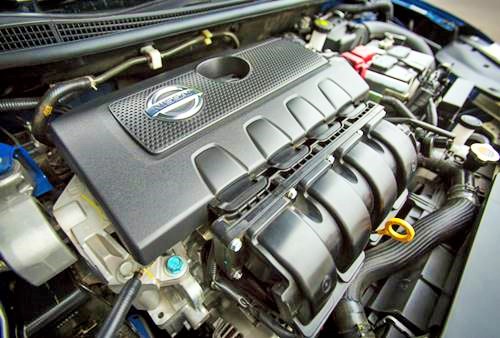 |
| Under the hood of the Sentra Nismo is a 1.6-liter four-cylinder engine that makes 188 horsepower and 177 pound feet of torque. |
Powering the upcoming Sentra Nismo
will be the same 1.6-liter turbo found under the SR Turbo model. That’s
somewhat a bummer, as I expected horsepower output to be increased at least somewhat.
With some modifications, however, I imagine the car could surpass 200
horsepower and really begin to put a smile on some buyers’ faces. Other notable
mechanical upgrades the Sentra Nismo will receive are increased body rigidity
and suspension and steering tuning to compensate for more spirited driving.
Note: The previously mentioned new SR Turbo model already received stiffer
front springs and stiffer front and rear dampers as upgrades. So, these Nismo
upgrades are on top of those ones that were already applied. Therefore, I would
expect quite a stiff ride out of the Sentra Nismo. But then again, the potential
gains in performance and handling may offset that. I imagine that the CVT and
manual transmission options may both carryover (though a manual would be preferred
for most on a Nismo I’m sure). On the interior, one will find new performance
seats, carbon fiber-style instrument panel inserts, Nismo badging, Alcantara
and suede accents, along with other trim-specific materials.
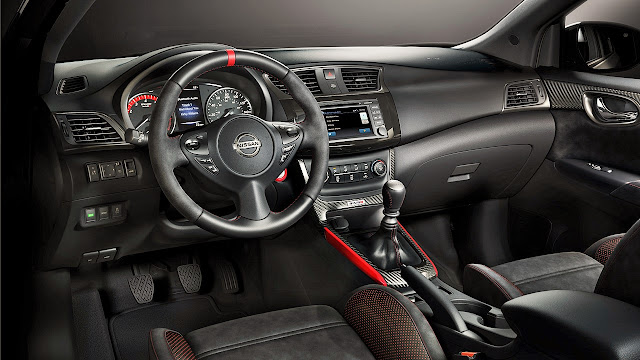 |
| From the looks of it, this interior on the Sentra Nismo is much improved over the base models of the Sentra. I approve. |
Nissan says that Sentra sales are up, and that they’re looking to grow in this performance segment. Who knows, this just may be the model to do it for them. What are your impressions? Look for the Nissan Sentra Nismo to release with a price tag of less than $25,000 in January 2017.
Copyright © 2016 Adam's Autos, All Rights Reserved.
Sunday, November 6, 2016
3 Cool Cars from SEMA 2016!
If you love
cars, you probably dream of customizing one in some whacky way and selling it
for some serious money someday! If not that, then you at least probably dream
of owning something that is unique and gets you a ton of attention. Look no
further, because some of the wildest, most eye-catching automotive creations
out there can be found at the SEMA show! Each year, this show takes place in
Las Vegas, Nevada and draws both domestic and international buyers. There’s all
kinds of networking opportunities available for those there, but the event isn’t
open to the public. Thus, attending this show someday could be something you
put on your bucket list perhaps!
That all being said, here’s three
of my favorite cars I saw online from SEMA 2016:
1. Dodge
Durango Shaker concept
This here
should intrigue your mind just a little bit! Rumor has it that we may see an
SRT version of the Durango soon with the 392 Hemi under the hood. It may seem
silly that a family crossover vehicle would sport performance like that, but
this is Dodge after all. And this fully functional Durango Shaker concept in
Dodge’s classic B5-blue color may somewhat hint at the upcoming model. Dodge,
however, has cautioned people and said don’t read into this too much and that
they’re just “having some fun.” They must’ve had quite a bit of fun, as there
are Viper seats for all three rows on the inside, Hellcat airflow headlights in
place of the fog lights on the outside, dual center tailpipes, and 22-inch rims
complimenting a sport-tuned suspension and other styling cues such as an all-black
roof and black American flags. It certainly looks like no other Durango you’ve
ever seen before! And who knows what this means for a potential SRT model that’s
possibly in the works.
2. 1958 Chevy
Corvette
There’s
always just something about a Corvette, and this one is no exception. Beautifully maintained, this Vette belongs to Heartland Customs and has an LS7 V8 under the
hood and a 5-speed automatic transmission with a Hurst short-throw kit. It also
has an independent suspension with adaptive dampers, making it decidedly modern
and stealthy all in the same instance. What particularly caught my eye was the
cream interior. You just don’t see something so beautiful even on cars that are
new! You really can’t beat the classics oftentimes.
3. The
Batmobile
Ok, let’s face
it, who isn’t a fan of Batman? He’s had some of the most interesting, if not
slightly ridiculous, automobiles over the years. And this version of his iconic
Batmobile is no exception. All its possibly missing is him at the wheel.
Did you
follow SEMA 2016? If so, what did you see that caught your eye?
Until next
time, ROLL ON!
Copyright © 2016 Adam's Autos, All Rights Reserved.
Old Segment, New Face: At Last, The Atlas Arrives
Do you want
a large crossover SUV that seats six or seven people, but at the same time have
no desire for a Chevrolet, GMC, Dodge, Honda, Toyota, Ford, Mazda, Nissan or
any other veteran player in the segment? Well, Volkswagen may just have some good
news for you. In an earlier post on Adam’s Autos, I discussed how VW is hard at
work trying to revise their product lineup and that a new (previously unnamed)
7-passenger crossover was among the planned upcoming models. Now, we can
officially put a name with this new face. Recently, the automaker unveiled
their upcoming 2018 Atlas crossover, and as the saying goes: Better late than
never.
While not
everyone’s heart will be set ablaze by the arrival of the Atlas, it’s hard to
deny that the absence of a true “family hauler” in VW’s lineup was quite
noticeable. Especially given how competitive the large crossover SUV segment is
now and the sheer number of entries in the segment too. Originally previewed
back in 2013 (under the guise as the CrossBlue concept car), the new Atlas will
now put to rest claims the Volkswagen was totally ignoring this segment and
will serve as the brand’s largest model sold in the United States.
Additionally, the Atlas will have a U.S.-exclusive name and be built right here
in the U.S. at VW’s Chattanooga, Tennessee plant.
Tailor Made
Being a
model that is specifically tailored for American families and roadways, you can
expect that features and powertrains will also follow suit and appeal to
American buyers. A 2.0-liter turbocharged 4-cylinder making 238 horsepower will
be standard on entry-level Atlas models. I imagine that while this sounds like
that will be enough power on paper, the optional 3.6-liter VR6 engine that produces
280 horsepower will likely prove in testing to be the superior choice for a
vehicle of this size. Both engines will be paired to an 8-speed dual-clutch transmission.
VW’s 4Motion all-wheel-drive system will be optional on 6-cylinder models, but 4-cylinder
models will be front-wheel-drive only. All the latest technological and safety
features, such as Android Auto and Apple CarPlay, Fender premium audio, VW’s
Digital Cockpit, automatic emergency braking (includes pre- AND post-collision braking),
active lane-keep assist, forward collision warning, and more will all either be
standard or available as options on certain trim levels. Among the unknown
details are fuel economy specifications and pricing. However, Volkswagen claims
that since the Atlas will be produced in the United States, it will be able to
be priced competitively within the crossover SUV segment. If this truly does
give VW a competitive advantage in the showroom department, then it’s
imperative that the Atlas drives and is put together well so it will win in the
appeal department too. VW also claims
that the Atlas will indeed drive better and have superior fit and finish when
compared to its competition. However, doesn’t everyone say this initially? I
say time will tell, especially once actual production models come off the
assembly line.
So now, what
are your first impressions of the new Volkswagen Atlas? Do you think it will be
successful in the already crowded crossover SUV segment? Personally, while I
think VW was long overdue for an entry into this segment, I’m not entirely sure
we needed another family-oriented crossover option this late in the game.
Especially since there are already so many successful entrants, such as GM’s
trio of crossovers, Ford’s Explorer, and Honda’s Pilot to just name a few. To
say the Atlas has steep competition would be an understatement. And it’s
somewhat (in my eyes) bland styling doesn’t help its case. Although available
LED running lights, LED headlights, and available LED taillights will all
certainly add to the crossover’s upscale ambiance. The side profile of the
Atlas also appears to be more “rugged looking” than some competitors, and thus
may attract some people who are, again, looking for something a little less “conventional”
than say, a Chevy Traverse. Despite the company’s timing, the Atlas is a solid
first attempt an American-tailored, family-oriented crossover with plenty of
features and technology to go around. Look for it to arrive at VW dealers in the spring of
2017.
Copyright © 2016 Adam's Autos, All Rights Reserved.
Subscribe to:
Posts (Atom)
